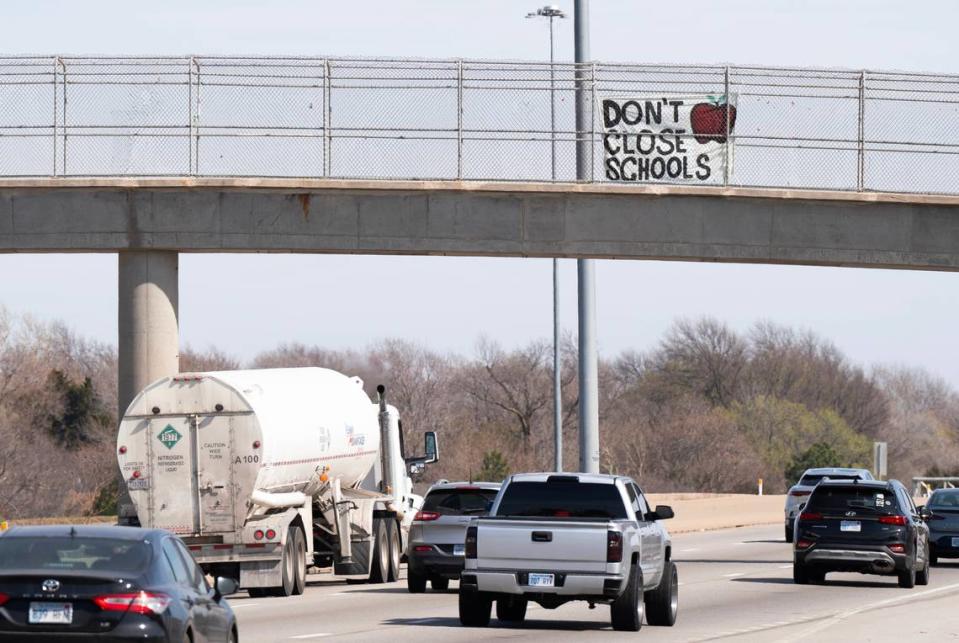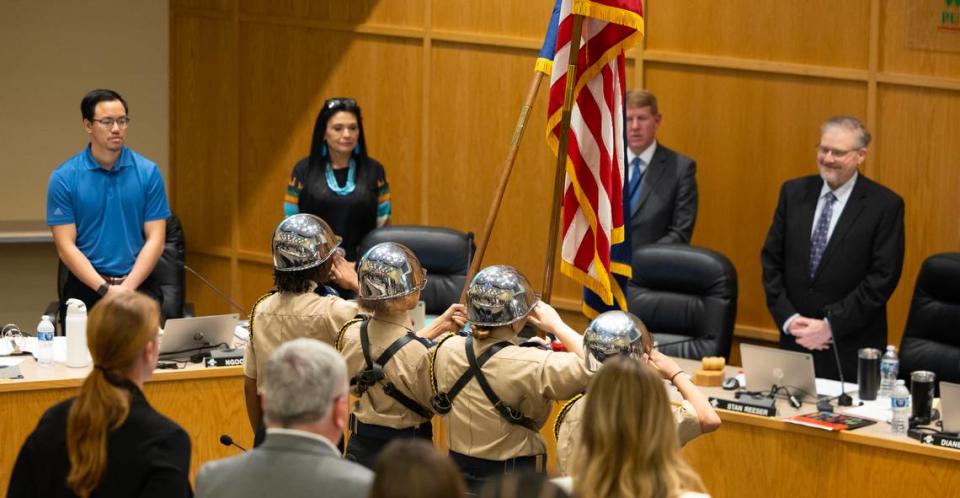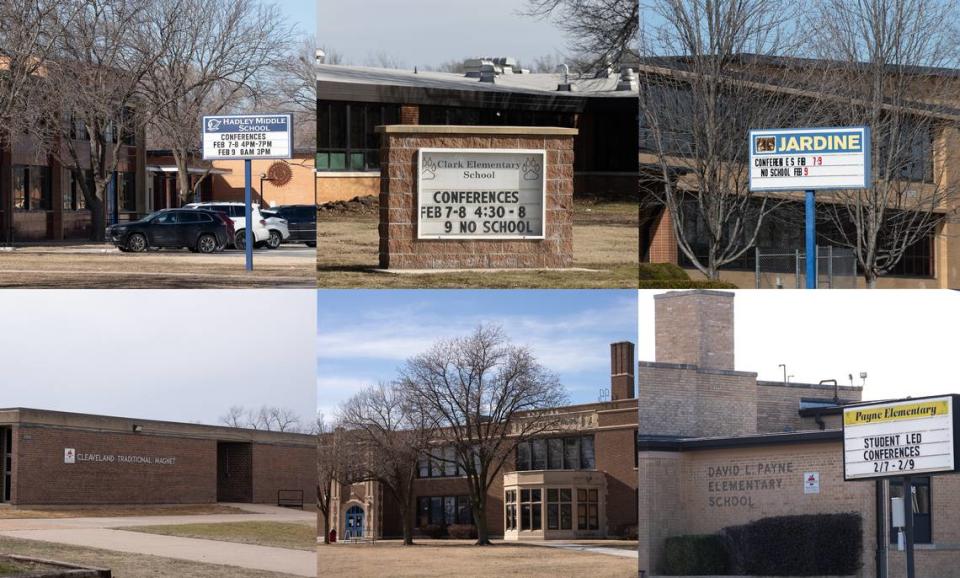Split Wichita school board votes to close six schools as cost-saving measure
Six Wichita schools will be permanently closed at the end of the semester.
The school board voted 5-2 Monday night to shutter Clark, Park, Payne and Cleaveland Magnet elementaries and Hadley and Jardine Magnet middle schools.
The board’s two newest members, Melody McCray-Miller and Ngoc Vuong, voted against the closure recommendation, voicing concerns about a lack of meaningful community input.
The closures will affect 2,213 students and 322 employees. The employees have been told they will be offered a position elsewhere within the district next year if they go through an application process.
“Although tonight is very painful and we know the people we care about and serve are going to experience grief because of their loss, I will vote in favor of the motion because I think it’s the most equitable and wisest way possible in the constraints of time and budget for us to move forward,” board member Julie Hedrick said.
District officials say the consolidation will save an estimated $16.2 million — money needed to help plug a $42 million budget hole that was first publicized in January, when board members were told they needed to choose between closing schools and laying off teachers and other employees.
“Informing the public early and often of this impending shortfall would have gone a long way to creating what I would call a common understanding with the intent of garnering public consensus and support,” McCray-Miller said.
“The listening sessions and the public hearing held recently may have been designed to listen and document statements. However, they were not designed to allow our stakeholders true input to be considered in the final solutions.”

USD 259 is the largest public school system in Kansas. Enrollment has declined by 8% since 2016, cutting down on the per-pupil funds the district receives from the state. The shortfall also coincides with the exhaustion of $263 million in federal COVID-19 relief money.
“The consequences of remote learning as a result of school closures during COVID drove parents to send their students to private schools or choose to homeschool,” board member Kathy Bond said.
“Now, we have too many buildings and not enough students to fill the classrooms . . . This decision cannot be delayed or pushed down the road anymore without putting this district in serious jeopardy. If we do not take drastic action right now, we could in effect create a situation where our school district cannot survive because we didn’t take the measures to stop the bleeding.”
Vuong, who along with McCray-Miller was sworn in as a board member the same day USD 259’s budget shortfall was made public, said the closure process has moved too quickly. Board members were told in February when closure recommendations were made that there was not enough time to consider alternative buildings for closure.
“I can recognize the need to close schools while also recognizing that my principles of equity, true community oversight of our school district, true financial oversight of our school district, has been violated,” Vuong said.
“Long-term, we have to have many more options in terms of making any decision that pertains to the responsible stewardship of resources.”

Beyond building closures, the district hopes to save $9 million through a variety of cuts, including trimming all non-school programs by at least 5% and scaling back the number of schools that participate in the Advancement Via Individual Determination (AVID) college readiness program. That leaves a $16.8 million budget hole that still needs to be filled.
“From the COVID years, we do have some cash reserves, so we think we can finish up that last portion of the hole with some cash, through attrition and through the possibility of savings that we can find here and there,” board President Stan Reeser said before Monday’s meeting.
He would not rule out the possibility of additional school closures or a bond issue to help the district address its $1.2 billion in deferred maintenance needs.
“Best case scenario is, we won’t have to address this anytime soon. But obviously there’s no guarantees,” Reeser said.
Wichita Public Schools has permanently closed 42 school buildings in its 154-year history, district spokesperson Susan Arensman said. Ten schools that closed as regular attendance centers are now used as magnets or to house special programs, including the former Emerson Elementary, which was reopened in 2016 as the Gateway Alternative Program Center, and the shuttered Bryant Magnet Elementary, which was repurposed as Bryant Opportunity Academy in 2018.
Recommendations about what to do with the closed schools will likely be included in the district’s 10-year facilities master plan, which is expected to come before the board in May or June. The state of Kansas will have right of first refusal on the buildings.
Before closures can be finalized, state law requires a 45-day period for residents to lodge an administrative review with the state board of education. To register an administrative review, petitions must be signed by at least 5% of registered voters within district boundaries.

Where will students go?
Here’s where the district plans to send affected students:
Hadley students will go to Hamilton, Marshall, Pleasant Valley and Wilbur.
Neighborhood students at Jardine Magnet will be reassigned to Mead and other magnet students from around the city will be allowed to apply with priority to any of the district’s other magnet schools or attend their own neighborhood school.
Clark students will be distributed between Caldwell, Beech and Allen elementaries.
Cleaveland is a traditional magnet that pulls students from all around the city. Students can either attend their own neighborhood school or apply with priority to another magnet program.
Park students will be distributed between Irving, Washington, Harry Street and Linwood elementaries.
Payne students will be distributed between Lawrence, Stanley and Woodman elementaries.
The district has extended its magnet application deadline through March 22 to accommodate families that want an alternative to the new school their student is assigned to. Only students who attended a magnet school that is being closed will be given priority in the magnet lottery process. Families can also request a special transfer to another city school, but transportation will not be provided.

